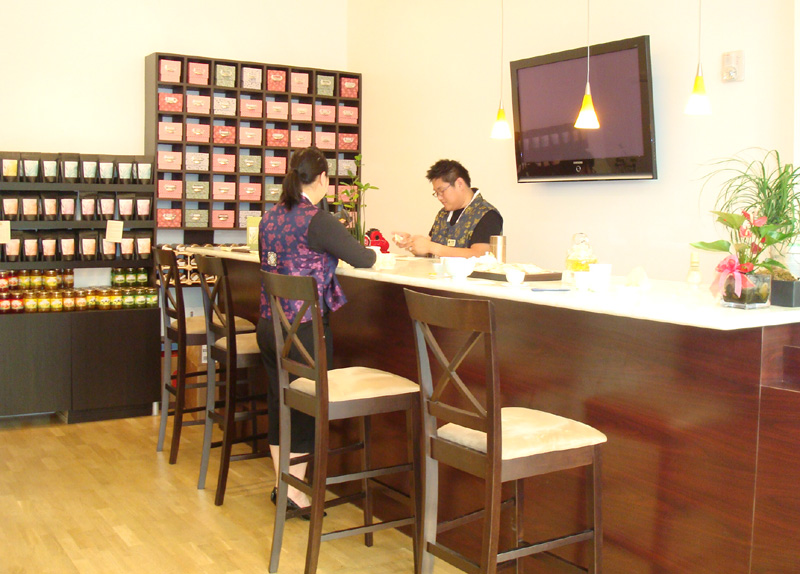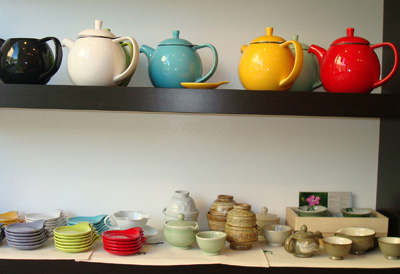Korean Tea, Part 1: The New
You’ve enjoyed trendy wine bars. Now, take a seat at a soothing tea bar.
Puripan Tea Garden opened its doors a month ago at San Jose’s Santana Row. This cozy oasis sells 70 types of loose-leaf teas, the majority of them Korean. Although Koreans traditionally don’t drink black teas, the store has imported a range of black teas from India and China, as well.
If your experience with tea has been limited to the bagged variety, you are in for a treat here. Most run-of-the-mill tea bags contain more tea “dust” than actual leaves. Glass containers here display tea leaf samples that can be opened to experience their intoxicating fragrances.

Besides many types of green tea, Koreans have a tradition of brewing tea from grains such as corn and barley, as well as more unusual plants such as persimmon leaves. Store proprietor Ellen Kim explained that during Korea’s Chosun Dynasty (the 1300s), the tax on tea was so high that people resorted to brewing “tea” with other ingredients.
Puripan, the largest fermentation company in Korea, also makes a popular “Tea in a Jar.” It is a fermented fruit tea. Ginger or fruit such as yuzu or papaya are layered with organic sugar and natural honey in large pottery jars. The contents are stirred every few days in a process similar to making kimchee. When the fruit tea is ready, just add 2 teaspoons or so to a cup of hot or cold water for a soothing elixir.
You can try the “Tea in a Jar” or any of the loose-leaf teas for free at the shop. Take a seat at the small bar, and your selection will be brewed to exact specifications so you can try it before buying. Free tea snacks, such as sesame cookies or homemade muffins made with tea infusions, can be enjoyed, too.
The loose-leaf tea ranges in price, depending upon the variety, from $3.99 for 2 ounces (enough for 40 cups) to $49.99 for 2 ounces.

Puripan Tea Garden is open 10 a.m. to 9 p.m. Monday through Saturday; and 11 a.m. to 7 p.m. on Sunday. It’s a good thing, too, because this is one bar where you won’t get tipsy, and you won’t want to leave.
Tomorrow: A more traditional Korean tea house.


Interesting find!
How does this compare to Lupicia?
Oh, I like Lupica teas, too. I think Lupica teas are a little more Californian/European in variety, whereas Purpipan Tea Garden specializes in Korean teas. Some are quite unusual, too, like the toasted or roasted grain ones made from corn and barley. It’s a fun place to relax for a spell, and you’ll walk away with quite an education in Korean tea, too.
We love to drink mugicha, and recently discovered Korean roasted corn tea. They’re pretty easy to find in the Korean groceries around here.
Re: your comment on our Thien Long Restaurant post – no, Thien Long doesn’t serve Banh Xeo. For that we go to Tay Ho on Senter Rd near Lewis.
Maybe we should give Vung Tau another shot.
whoops. Checked their menu again and found that Thien Long does have Banh Xeo as an appetizer.
Oh yum, I love Bahn Xeo. I make it at home at least once a year, but it does take a fair amount of prep work. Still, it’s worth the effort.
Tay Ho _ a blast from the past. It used to be located in downtown San Jose. When I worked at the Mercury News, it was one of my fave places to go for lunch. In fact, it was the first place I tried Banh Xeo. I was glum when it moved to Grand Century Mall — nicer digs, but too far to venture for lunch on a work day. But now that I’m not at the Merc, I can take as long of a lunch as I want. It’s definitely one big benefit to being laid off. 😉
i love this tea!! My mom calls it BoRi Cha (barley tea i think?? but it looks more like corn, or it is mixed). It is good cold or hot!! In the winter, we brew it for colds and for something warm to drink, and in the summer, it is good cold and a replacement for water!! Drinking it also is rumored to help lose weight and is a detox
Oh, I didn’t even think about how it might taste cold. I bet that is good. With the weather getting chilly, I look forward to enjoying more of the hot teas, too.
Hi,
We love Korean tea so much that we decided to try to form a tea tour to Korea. Brother Anthony (An Sonjae) and Hong Kyeong-hee co-authors of the Korean Way of Tea will host the tea portion of the tour. THe tour will trace bothe Korean tea and tea ware. Among other events there is a temple stay where we will pick and hand process wild tea. As we are non-profit we have only word of mouth to promote this. Go to TeaTourKorea.Com to learn more. Thank you.
Morning Earth
Are Korean teas more like loose leaf teas? Or are they more like iced teas? I’d be interested in trying some different kinds, although I am partial to the loose leaf teas I’ve found in other countries.